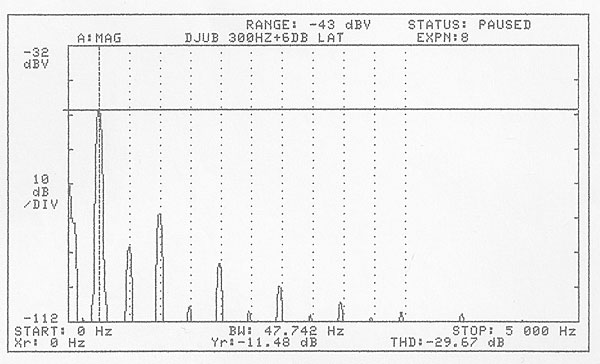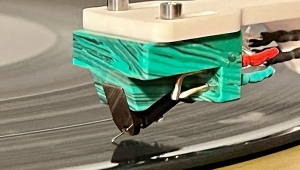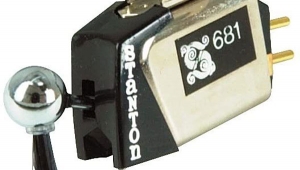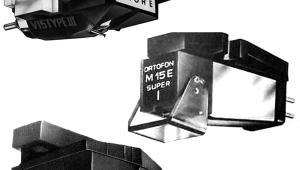| Columns Retired Columns & Blogs |
London (Decca) Jubilee/Reference phono cartridge Measurements
Sidebar 4: Measurements
The Jubilee's frequency response (fig.1) was better than that of the older Decca designs. The omnipresent bass wiggles were now confined to a gentle rise toward 20Hz. Likewise, the 250Hz region was uniformly flat. There was just the gentlest of downward tilts, 0.5–0.75dB, from 100Hz to 5kHz. While the range above 5kHz was mildly perturbed (+1dB, –3.5dB), matters roughly balanced out over the final octave. Significant high-frequency resonances were held off until 24kHz.

Fig.1 London Jubilee, outer-band frequency response and channel separation after RIAA correction (right channel and R–L dashed, 10dB/large vertical div.).
Channel balance was excellent at typically ±0.3dB up to 5kHz. Channel separation was also pretty good, averaging a fine 30dB over the vital midband, and hanging in there with 20dB or so from 5kHz to 15kHz.
Those graphs are of necessity taken at moderate levels, and cannot describe the performance at peak levels. My test records would rapidly wear out if I played the higher modulation levels with the Jubilee.
Tracking tests explored the margins of the Jubilee's performance. The highest levels of modulation are typically found in the low midrange. The classic tracking test thus involves a 300Hz tone. Using CBS's STR112, the Jubilee was fairly good on the lateral band at the rated downforce. The +15dB cut (ref. 5cm/s) was handled stably, but the 18dB torture track was beyond it. Not even 2.5gm downforce would encompass 300Hz at +18dB modulation.
On the vertical cut, while +6dB was tolerated, +9dB gave periodic mistracking, the loss in groove contact associated with bursts of ultrasonic ringing at one of the armature's free resonance-mode frequencies. These bursts reached about half the amplitude of the mistracked waveform; while they are ostensibly inaudible, they may not be harmless in that they may upset components in the succeeding chain—particularly the phono preamplifier or power amplifier. Perhaps this is why the mistracking, when it did occur, was more aurally offensive than usual.
A glimpse of this ultrasonic ringing (though not so severe, as groove contact was hopefully maintained with this signal) may be seen in the squarewave response (fig.2). Here, the leading edges, while featuring a short risetime, did have significant overshoot accompanied by high-frequency ringing. The shape was generally "square," confirming the cartridge's essentially uniform frequency response.

Fig.2 London Jubilee, 1kHz squarewave after RIAA correction.
I found a correlation between the variation of sound quality between soft and loud passages and the Jubilee's distortion levels. At low modulation levels, distortion was satisfactory; while it was higher than with most phono cartridges, it was still below 1%, and not of great subjective significance. However, the picture changed above 10cm/s modulation, where the Jubilee featured an increasing dominance of odd-order harmonics at levels where they would be audible. Certainly they would contribute to an altered tonal quality.
Fig.3, for example, shows the spectrum for a laterally modulated 300Hz tone 6dB above reference level. The dominance of the odd-order harmonics (due to magnetic nonlinearity) can be seen, with the third harmonic highest at 2.8%. The overall distortion level was 3.2%. At the +15dB lateral-tracking limit (fig.4), the higher orders emerged, giving rise to "rasp" and "sharpness." The overall level of distortion had risen to –19.9dB—a well-audible 10%.

Fig.3 London Jubilee, spectrum of lateral 300Hz sinewave, DC–5kHz, at +6dB ref. 5cm/s (10dB/vertical div.). The third harmonic is the highest in level at –32dB (2.8%).

Fig.4 London Jubilee, spectrum of lateral 300Hz sinewave, DC–5kHz, at +15dB ref. 5cm/s (10dB/vertical div.). The third harmonic is the highest in level at –20dB (10%).
In the vertical plane (+6dB modulation), a different nonlinearity emerged: the 3.5% distortion figure was dominated by the second harmonic (shown in fig.5). This is due to the "one-sided" compliance resulting from the Decca design's vertical restraint and damping system. Higher modulation levels resulted in a spray of upper harmonics plus ringing well above 30kHz.

Fig.5 London Jubilee, spectrum of vertical 300Hz sinewave, DC–5kHz, at +6dB ref. 5cm/s (10dB/vertical div.). The second harmonic is the highest in level at –30db (3%).
Mounted in the Naim ARO arm, the Jubilee's vertical arm/cartridge response lay in the 15Hz region, and was well-damped. The lateral resonance was rather lower at 7.5Hz and had a high Q. With full damping applied to the Decca International tonearm, for example, the rise at resonance was still 9dB, with visibly obvious arm motion. The lower resonant frequency remained uncomfortably close to the complex harmonics of a suspended-chassis turntable such as a Linn. Ideally, both infrasonic resonances should be in the 10–12Hz region and well-damped (a moderate Q of 2–3).—Martin Colloms
- Log in or register to post comments



































